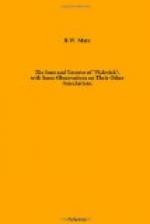It was here, too, that Tony, with the laudable intention of helping Mr. Pickwick, offered the invaluable, and now historic, advice concerning an “alleybi,” there being, as he asserted, “nothing like a’ alleybi, Sammy, nothing.”
It was in the same parlour on the same occasion that Mr. Weller, senior, informed his son that he had two tickets “as wos sent” to Mrs. Weller by the Shepherd “for the monthly meetin’ o’ the Brick Lane Branch o’ the United Grand Junction Ebenezer Temperance Association.” He communicated the secret “with great glee and winked so indefatigably after doing so,” “over a double glass o’ the inwariable,” that he and Sam determined to make use of the tickets with the projected plan of exposing the “real propensities and qualities of the red-nosed man,” the success of which is so well remembered.
These facts in mind the “Blue Boar” ought not to be passed over lightly, even though it cannot be identified by name, or its existence traced in historic records. In those days the description of the locality given by Dickens was accurate enough; but although there were many inns and taverns in its district, topographers have never discovered a “Blue Boar,” or learned that one ever bore such a sign. There was a “Bull” in Leadenhall Street at one time, and possibly this may have been the inn the novelist made the scene of the above incidents, simply giving it a name of his own to afford scope for his whimsical vein in describing it.
However, the locality has changed completely from what it was when Tony Weller “used the parlour” of the “Blue Boar,” and such coaching inns that flourished then have all been swept away with the “shabby courts and alleys.”
We find, however, a picture purporting to be the “Blue Boar” with its galleries, horses and stable boys all complete drawn by Herbert Railton, in the Jubilee edition of The Pickwick Papers. Probably this is purely an imaginary picture.
On the other hand, there was nothing visionary about Garraway’s. “Garraway’s, twelve o’clock. ’Dear Mrs. B., Chops and Tomato Sauce, Yours, Pickwick,’” not only implicated Mr. Pickwick, but conjured up an old and historic coffee house of city fame. It stood in Exchange Alley, and was a noted meeting-place for city men, and for its sales and auctions. It was demolished some fifty years ago after an existence of over two hundred years. It claimed to be the first to sell tea “according to the directions of the most knowing merchants and travellers into the eastern countries,” but ultimately became more famous for its sandwiches and sherry. No doubt it was the latter, or something even more substantial, that Mr. Pickwick had been indulging during the day he wrote that momentous message. Garraway’s was known to Defoe, Dean Swift, Steele and others, each of whom have references to it in their books, and during its affluent days it was never excelled by other taverns in the city for good fare and comfort. It was there that the “South Sea Bubblers” frequently met.




